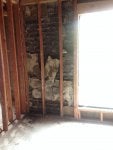Masonry Question, Lumber Question or Both?
I visited a potential job yesterday in Nola. The job is a multifamily rehab, the buildings have already been gutted and all that is left is studs and the exterior shell. Based on our walkthrough we noticed quite a bit of water damage so several studs and plates will for sure need to be replaced...pretty simple fix.
The brick seems to be a big issue. Just for reference the buildings were built in 1973. It appears that the sheathing is labeled as Temple IB Insulated Sheathing...(I'm not familiar with it or what its composed of).
In some areas the brick has separated from the walls, I assume the brick ties have pulled out from the studs bricks or both. How would you fix that?
The major issue is one where the sheathing behind the brick is completely gone! You could see the black sheathing in some areas and it looked like in good condition. In another area I would see a grey/white sheathing and it would be super brittle and would just fall down if kicked. And then there were other areas where there was no sheathing at all. We're at a loss on what to do to fix it? Is it a complete tear down or is there a way to fix it?
I visited a potential job yesterday in Nola. The job is a multifamily rehab, the buildings have already been gutted and all that is left is studs and the exterior shell. Based on our walkthrough we noticed quite a bit of water damage so several studs and plates will for sure need to be replaced...pretty simple fix.
The brick seems to be a big issue. Just for reference the buildings were built in 1973. It appears that the sheathing is labeled as Temple IB Insulated Sheathing...(I'm not familiar with it or what its composed of).
In some areas the brick has separated from the walls, I assume the brick ties have pulled out from the studs bricks or both. How would you fix that?
The major issue is one where the sheathing behind the brick is completely gone! You could see the black sheathing in some areas and it looked like in good condition. In another area I would see a grey/white sheathing and it would be super brittle and would just fall down if kicked. And then there were other areas where there was no sheathing at all. We're at a loss on what to do to fix it? Is it a complete tear down or is there a way to fix it?







